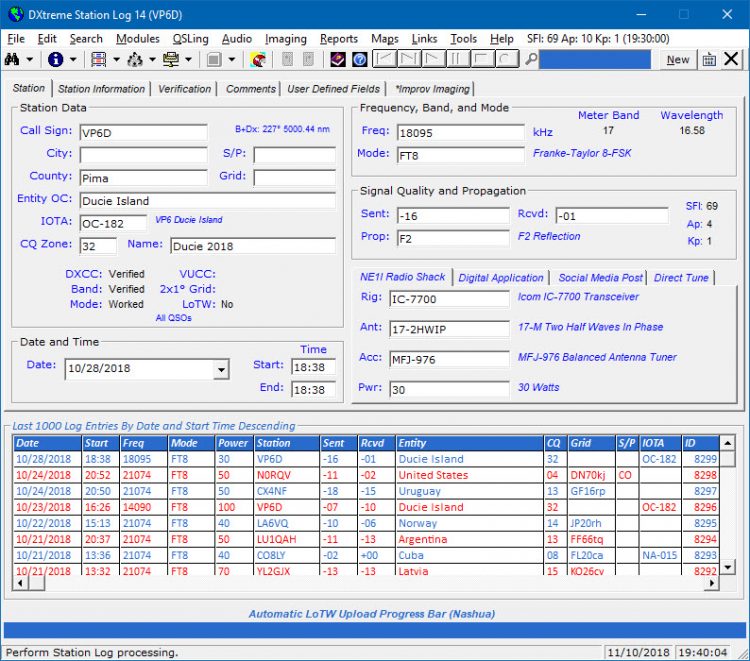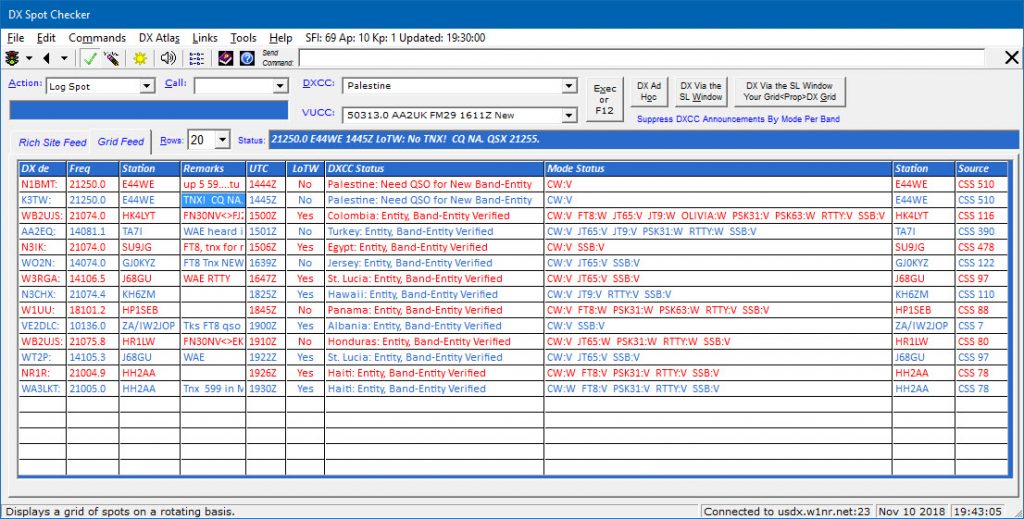Many thanks to SWLing Post sponsor, Bob Raymond with DXtreme Software, for sharing the following press release:
Product Announcement DXtreme Station Log 14
DXtreme SoftwareTM has released a new version of its popular logging program for Amateur Radio operators: DXtreme Station Log 14TM.
New Features in DXtreme Station Log 14
- DX Spot Checker Now Has Two Presentation Modes — Users can switch between Rich Site Feed and Grid Feed by clicking a tab on the window. The Rich Site Feed displays the actual, continuous feed from the Telnet server, and lets users interact with the server to set options like server-side filters and to perform queries. The new Grid Feed displays 10 to 50 rows (user’s choice) of DX spots in a structured, resizable, alternating-color grid. Grid-Feed spots can be displayed on a rotating basis (erase then continue) or by overwriting spots already displayed, as selected on the DX Spot Checker toolbar. Users can set fonts and colors for both feeds.
- Suppress Verified Spots by Mode Per Band — When activated in DX Spot Checker Options, this client-side filter lets users suppress the display of spots for modes already verified within band plans defined on the Modes-Per-Band Plans tab.
- JT Log Entry Processing — Users can have DXtreme Station Log 14 manage the pre- and post-log-entry population of the WSJT-X and JTDX log files, letting users perform all logging operations on the Station Log 14 window while keeping their eyes glued to the WSJT-X or JTDX interfaces for worked-before status indications. This feature is important when using quick modes like FT8.
- Digital Application Assignment — When users add a JT log entry via JT Log Entry Processing, the Digital Application Used field is populated automatically with either WSJT-X or JTDX as appropriate. When using other applications, users can edit this field manually. And they can assign digital applications to pre-existing log entries by mode globally, filtered or unfiltered by date and band.
- Club Log Record Creation — Users can create Club Log records in a special workfile automatically when adding or modifying log entries. The workfile can be viewed and edited, if needed, and uploaded via the Club Log web site. A Batch Upload to
Club Log function is available when Club Log does not contain all log entries.
Standard Features in DXtreme Station Log 14
DXtreme Station Log 14 lets hams log their contacts and import ADIF files from other programs. It supports major call sign subscription services, and offers the following multimedia and advanced functions:
- DX Spot CheckerTM — Receives DX spots from Telnet-based servers and determines whether QSOs are needed for new or verified DXCC® entities, band-entities, mode- entities, or VUCC grids. Information displays on Rich Site Feed and Grid Feed tabs.
- Automatic LoTW Upload — Users can set Station Log 14 so it uploads each log entry to LoTW automatically when added, capturing and saving QSO Record Status from the LoTW server as part of the process. Modified log entries can be uploaded as well. If desired, users can disable automatic uploading and can upload log entries to LoTW semiautomatically and manually in batches whenever they want to.
- LoTW Reporting — Users can perform searches and run reports filtered by LoTW QSO Record Status, which indicates whether log entries are On, or Not On, the LoTW server following upload or QSL-updating. Users can also perform searches and run reports filtered by LoTW QSL Record Status, which indicates the date of each LoTW QSL record processed by DXtreme’s LoTW QSL Update Utility.
- DX Atlas Integration — Performs Afreet DX Atlas azimuth plots from the user’s location to that of a spotted or logged station. Also creates maps for reports.
- Rig Control — Tunes/retrieves frequencies and modes from supported rigs through integration with Afreet Omni-Rig.
- QSL Processing — Creates QSL and address labels for physical QSLs, and supports the ARRL’s LoTW facility, including capturing LoTW QSL records as digital images.
- QSL ImagingTM — Lets users scan and capture QSL cards and electronic QSLs into their log entries for browsing and viewing any time they want to.
- Improv ImagingTM — Lets users associate adhoc images with their log entries separate from our popular QSL ImagingTM facility. Users can capture, scan, or paste any image and save it as a single-page .jpg, or single- or multi-page .tif. Improv images popular with users include signals on a spectrum analyzer or waterfall, QSOs conducted on ATV and data applications, and equipment used during contacts.
- Audio Facility — Records and plays QSOs.
- Reports — Provides a wide range of performance and station reports to let users see how well they’re doing. Reports can be filtered and sorted. Includes DXCC® and WAS AnalyticsTM tools for analyzing and enhancing DXCC and WAS standing.Operating System and Requirements, Pricing and Support
DXtreme Station Log 14 runs in 32- and 64-bit versions of Microsoft® Windows® 10, Windows 8.1, Windows 8, Windows 7, Windows Vista®, and Windows XP. It retails for $89.99 USD worldwide for Internet distribution. Reduced pricing is available for upgrading users. All prices include product support by Internet e-mail.
About DXtreme Software
Based in Nashua, NH, DXtreme Software produces powerful and easy-to-use logging applications for all kinds of radio enthusiasts — from short-wave and medium-wave listeners and DXers to Amateur Radio operators. For more information about DXtreme Station Log 14, visit www.dxtreme.com or contact [email protected].


